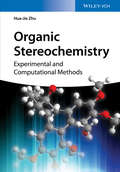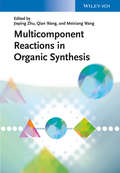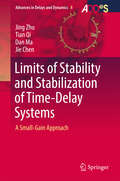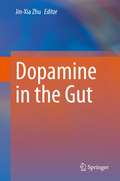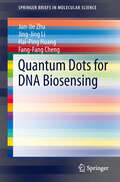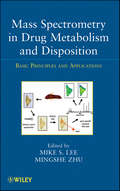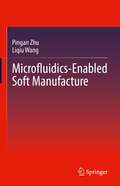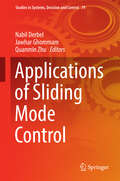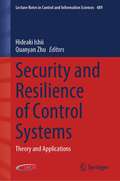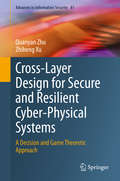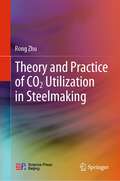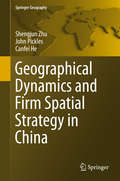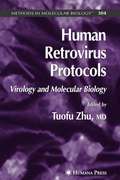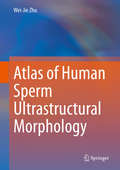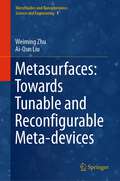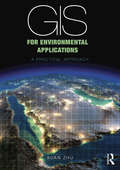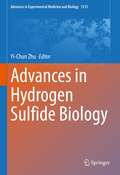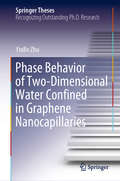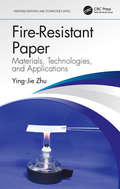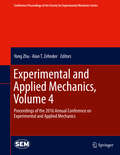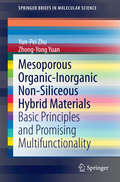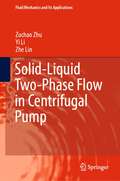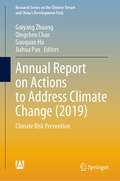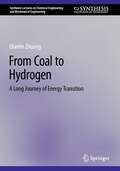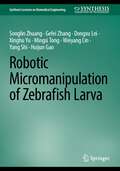- Table View
- List View
Organic Stereochemistry
by Hua-Jie ZhuAdopting a novel approach to the topic by combining theoretical knowledge and practical results, this book presents the most popular and useful computational and experimental methods applied for studying the stereochemistry of chemical reactions and compounds. The text is clearly divided into three sections on fundamentals, spectroscopic and computational techniques, and applications in organic synthesis. The first part provides a brief introduction to the field of chirality and stereochemistry, while the second part covers the different methodologies, such as optical rotation, electronic circular dichroism, vibrational circular dicroism, and Raman spectroscopy. The third section then goes on to describe selective examples in organic synthesis, classified by reaction type, i. e. enantioselective, chemoselective and stereoselective reactions. A final chapter on total synthesis of natural products rounds off the book. A valuable reference for researchers in academia and industry working in the field of organic synthesis, computational chemistry, spectroscopy or medicinal chemistry.
Multicomponent Reactions in Organic Synthesis
by Jieping Zhu Meixiang Wang Qian WangComprehensive and up-to-date, this book focuses on the latest advances in the field, such as newly developed techniques, more environmentally benign processes, broadened scopes, and completely novel MCRs. In addition to carbene-promoted MCRs and frequently applied metal-catalyzed MCRs, it also covers recently developed catalytic enantioselective variants as well as MCR in drug discovery and for the synthesis of heterocyclic molecules and macrocycles. Edited by the leading experts and with a list of authors reading like a "who's who" in multicomponent reaction chemistry, this is definitely a must-have for every synthetic organic chemist as well as medicinal chemists working in academia and pharmaceutical companies.
Limits of Stability and Stabilization of Time-Delay Systems
by Jing Zhu Tian Qi Dan Ma Jie ChenThis authored monograph presents a study on fundamental limits and robustness of stability and stabilization of time-delay systems, with an emphasis on time-varying delay, robust stabilization, and newly emerged areas such as networked control and multi-agent systems. The authors systematically develop an operator-theoretic approach that departs from both the traditional algebraic approach and the currently pervasive LMI solution methods. This approach is built on the classical small-gain theorem, which enables the author to draw upon powerful tools and techniques from robust control theory. The book contains motivating examples and presents mathematical key facts that are required in the subsequent sections. The target audience primarily comprises researchers and professionals in the field of control theory, but the book may also be beneficial for graduate students alike.
Dopamine in the Gut
by Jin-Xia ZhuDopamine is widely present in the central and peripheral nervous systems, as well as in non-nervous systems. Parkinson's disease is well recognized as a dopaminergic neurodegenerative disorder, and affected patients often show early signs of gastrointestinal disorders at initial stages of the disease. Apart from the changes that occur in emotion, movement behaviors, learning and memory, metabolism etc., dopamine has also been demonstrated to play very crucial roles in the functional regulation of peripheral organs such as the heart, blood vessels, kidneys, and gut. Most recently, dopamine function in the gut has received enormous attention. Not only does dopamine regulate gut motility, ion transport, and mucosal barrier, but it is becoming more pertinent that more than 60% of dopamine in the body stems from the gut, which has not yet been properly addressed and substantially explored. Therefore, this book will discuss the brain-gut axis by providing novel and significant insight into the essence of gut-derived dopamine in mammals. It aims to inspire further research on dopaminergic regulation of gut function and disease genesis.
Quantum Dots for DNA Biosensing
by Jun-Jie Zhu Jing-Jing Li Hai-Ping Huang Fang-Fang ChengThis book provides a broad introduction to all major aspects of quantum dot properties including fluorescence, electrochemical, photochemical and electroluminescence. Such properties have been produced for applications in biosensing, cell tracking, in vivo animal imaging and so on. It focuses on their special applications in DNA biosensing and provides readers with detailed information on the preparation and functionalization of quantum dots and the fabrication of DNA biosensors, using examples to show how these properties can be used in DNA biosensor design and the advantages of quantum dots in DNA biosensing. Further new emerging quantum dots such as metal nanoclusters and graphene dots and their applications in DNA biosensing have also been included.
Mass Spectrometry in Drug Metabolism and Disposition
by Mingshe Zhu Mike S. LeeThis book examines the background, industrial context, process, analytical methodology, and technology of metabolite identification. It emphasizes the applications of metabolite identification in drug research. While primarily a textbook, the book also functions as a comprehensive reference to those in the industry. The authors have worked closely together and combine complementary backgrounds to bring technical and cultural awareness to this very important endeavor while serving to address needs within academia and industry It also contains a variety of problem sets following specific sections in the text.
Microfluidics-Enabled Soft Manufacture
by Pingan Zhu Liqiu WangThis book covers state-of-the-art development in microfluidics-enabled soft manufacturing (MESM), ranging from fundamentals to applications. The book addresses the long-standing challenge in the manufacture of simultaneously achieving both precise control over nano-/micro-scale structures and large-scale fabrication of materials for pragmatic use, with microfluidics-enabled soft manufacture to fill the gap between the widely-varied length scales involved. It offers a comprehensive insight into the microfluidic generation of fluid systems as liquid templates, such as droplets, bubbles, jets, emulsions, and foams, which are categorized into individual templates, one-dimensional arrays, and two-/three-dimensional assemblies for the modular fabrication of microparticles, microfibers, and porous materials, respectively. MESM enriches the compositional and structural diversity of engineered materials for well-tailored properties and functionalities, markedly broadening the application horizons across interdisciplinary fields, including engineering, environment, physics, chemistry, biology, and medicine. This book aims to systematize this emerging yet versatile and powerful technology, with the hope of aiding the realization of its full potential. Microfluidics-Enabled Soft Manufacture will be an invaluable reference for graduate students, postgraduates, researchers, and practitioners/professionals working in micro and nanofabrication, materials science, surface science, fluid dynamics, and engineering.
Applications of Sliding Mode Control (Studies in Systems, Decision and Control #79)
by Quanmin Zhu Nabil Derbel Jawhar GhommamThis book presents essential studies and applications in the context of sliding mode control, highlighting the latest findings from interdisciplinary theoretical studies, ranging from computational algorithm development to representative applications. Readers will learn how to easily tailor the techniques to accommodate their ad hoc applications. To make the content as accessible as possible, the book employs a clear route in each paper, moving from background to motivation, to quantitative development (equations), and lastly to case studies/illustrations/tutorials (simulations, experiences, curves, tables, etc. ). Though primarily intended for graduate students, professors and researchers from related fields, the book will also benefit engineers and scientists from industry.
Security and Resilience of Control Systems: Theory and Applications (Lecture Notes in Control and Information Sciences #489)
by Quanyan Zhu Hideaki IshiiThis book comprises a set of chapters that introduce various topics pertinent to novel approaches towards enhancing cyber-physical measures for increased security and resilience levels in control systems. The unifying theme of these approaches lies in the utilization of knowledge and models of the physical systems, rather than an attempt to reinvigorate conventional IT-based security measures.The contributing authors present perspectives on network security, game theory, and control, as well as views on how these disciplines can be combined to design resilient, safe, and secure control systems. The book explores how attacks in different forms, such as false data injections and denial-of-service can be very harmful, and may not be detected unless the security measures exploit the physical models. Several applications are discussed, power systems being considered most thoroughly. Because of its interdisciplinary nature—techniques from systems control, game theory, signal processing and computer science all make contributions—Security and Resilience of Control Systems will be of interest to academics, practitioners and graduate students with a broad spectrum of interests.
Cross-Layer Design for Secure and Resilient Cyber-Physical Systems: A Decision and Game Theoretic Approach (Advances in Information Security #81)
by Quanyan Zhu Zhiheng XuThis book introduces a cross-layer design to achieve security and resilience for CPSs (Cyber-Physical Systems). The authors interconnect various technical tools and methods to capture the different properties between cyber and physical layers. Part II of this book bridges the gap between cryptography and control-theoretic tools. It develops a bespoke crypto-control framework to address security and resiliency in control and estimation problems where the outsourcing of computations is possible. Part III of this book bridges the gap between game theory and control theory and develops interdependent impact-aware security defense strategies and cyber-aware resilient control strategies.With the rapid development of smart cities, there is a growing need to integrate the physical systems, ranging from large-scale infrastructures to small embedded systems, with networked communications. The integration of the physical and cyber systems forms Cyber-Physical Systems (CPSs), enabling the use of digital information and control technologies to improve the monitoring, operation, and planning of the systems. Despite these advantages, they are vulnerable to cyber-physical attacks, which aim to damage the physical layer through the cyber network.This book also uses case studies from autonomous systems, communication-based train control systems, cyber manufacturing, and robotic systems to illustrate the proposed methodologies. These case studies aim to motivate readers to adopt a cross-layer system perspective toward security and resilience issues of large and complex systems and develop domain-specific solutions to address CPS challenges.A comprehensive suite of solutions to a broad range of technical challenges in secure and resilient control systems are described in this book (many of the findings in this book are useful to anyone working in cybersecurity). Researchers, professors, and advanced-level students working in computer science and engineering will find this book useful as a reference or secondary text. Industry professionals and military workers interested in cybersecurity will also want to purchase this book.
Theory and Practice of CO2 Utilization in Steelmaking
by Rong ZhuThis book analyzes the mechanism of the application of CO2 in steelmaking, by looking at the thermodynamics and kinetics of the reactions of CO2 with the elements present in molten steel. This book is the first academic monograph either at home or abroad on the application of CO2 in the steelmaking field. The thermodynamic conditions of the reactions of CO2 with silicon, manganese, phosphorus, chromium, nickel, vanadium, and other elements were calculated and analyzed using the FactSage thermodynamic software, and the selective oxidation law of the above multiple elements by CO2 was also analyzed. In terms of kinetics, the interfacial reaction mechanism of CO2 was analyzed via gas isotope exchange technology, and the O2 transfer process and transfer rate between the CO2, slag, and steel were studied. In terms of materials and energy balance, how to use the high-temperature characteristics of CO2 to control the temperature of the molten pool, improve the reaction conditions of molten iron, reduce the evaporation of molten iron, and reduce the amount of steelmaking dust were introduced. Based on the experimental data, theoretical models of unit operation for the application of CO2 in steelmaking were established, including decarburization, denitrification, dephosphorization, decarburization and chromium retention, vanadium extraction, and carbon preservation, and these theoretical models were applied to the steelmaking production process, which is an important step in going from theory to practice. The above research work has opened up a new solution for energy saving and liquid steel cleaning in the iron and steel production process and represents progress in steelmaking technology. This book is used as a reference book for managers, engineering and technical personnel, and related professional teachers and students of Iron & Steel enterprises, government departments, consulting services and evaluation agencies, colleges, and secondary professional schools.
Geographical Dynamics and Firm Spatial Strategy in China
by Shengjun Zhu John Pickles Canfei HeThis book offers the first detailed account of the complex geographical dynamics currently restructuring China's export-oriented industries. The topics covered are relevant to post-socialist geography, development studies, economics, economic sociology and international studies. It offers academics, international researchers, postgraduate and advanced undergraduate students in these fields an accessible, grounded, yet theoretically sophisticated account of the geographies of global production networks, value chains, and regional development in developing countries and emerging economies. It is of particular interest to economic geographers and economic sociologists involved in the growing debates over local clusters, embeddedness, global sourcing and global production, and over the global value chain/global production network. It also appeals to national policymakers, since it directly addresses economic and industrial policy issues, such as industrial competitiveness, regional and national development, industrial and employment restructuring and trade regulation.
Human Retrovirus Protocols
by Tuofu ZhuA cutting-edge collection of basic and state-of-the-art methods optimized for investigating the molecular biology of this class of retrovirus. These readily reproducible techniques range from methods for the isolation and detection of human retroviruses to cutting-edge methods for exploring the interplay between the viruses and the host. Here, the researcher will find up-to-date techniques for the isolation and propagation of HIV, HTLV, and foamy virus from a variety of sources. There are also assays for determining the cell tropism of HIV-1, the coreceptor usage of HIV-1, and human gene expression with HIV-1 infection by microarrays, as well as for phenotyping HIV-1 infected monocytes and examining their fitness. Highlights include the detection and quantification of HIV-1 in resting CD4+, a new cloning system for making recombinent virus, cDNA microarrays, and the determination of genetic polymorphisms in two recently identified HIV-1 co-factors that are critical for HIV-1 infection.
Atlas of Human Sperm Ultrastructural Morphology
by Wei-Jie ZhuThis atlas provides ultrastructural morphological images of human spermatozoa. Sperm morphology plays an essential role in sperm-oocyte interactions and early embryonic development, and human sperm ultrastructural morphology offers a valuable reference tool for assessing certain etiologies of male infertility and reproductive failure. However, the ultrastructural morphology of human sperm has not been systematically evaluated or thoroughly described in the literature. Using 470 original and unpublished images, the book shows various ultrastructural morphological phenotypes; defects of the sperm head, neck, middle piece, principal piece, and terminal piece; as well as artefacts of sperm ultrastructural morphology and phenomena related to inadequate preparation, demonstrating many sperm phenotypes and surface structural appearances for the first time. As such, it helps researchers and practitioners in andrology, reproductive medicine, and reproductive pathology gain a better understanding of human sperm ultrastructural morphology.
Metasurfaces: Towards Tunable and Reconfigurable Meta-devices (Microfluidics and Nanophotonics: Science and Engineering #1)
by Weiming Zhu Ai-Qun LiuMetamaterials and metasurfaces are developing exciting new frontier researches on reconfigurable materials with promising applications on tunable and active devices. The combination of metamaterials and microsystems not only uncap the controllability limits of optical metamaterials, but also pave the way for vast applications. This book focuses on structural reconfiguration of metasurfaces and metamaterials using microsystems, which have previously been developed for tiny machines and droplets formations. It covers multi-disciplinary researches on reconfigurable metamaterials and metasurfaces revealing their potential applications on densely integrated devices with working frequencies ranging from GHz to infrared region. Topics like MEMS metamaterials, frequency selective surface, photonic reconfigurable metasurfaces, and microfluidic metamaterials are just a few examples, which present lively research communities within the scope of this book. This book is intended for undergraduate and graduate students who are interested in fundamental science and technology of micro-optics and artificial materials, researchers in the field of reconfigurable and tunable metamaterials, and engineers working on tunable lens, Lidar, beam steering devices, or other applications.
GIS for Environmental Applications: A practical approach
by Xuan ZhuGIS for Environmental Applications provides a practical introduction to the principles, methods, techniques and tools in GIS for spatial data management, analysis, modelling and visualisation, and their applications in environmental problem solving and decision making. It covers the fundamental concepts, principles and techniques in spatial data, spatial data management, spatial analysis and modelling, spatial visualisation, spatial interpolation, spatial statistics, and remote sensing data analysis, as well as demonstrates the typical environmental applications of GIS, including terrain analysis, hydrological modelling, land use analysis and modelling, ecological modelling, and ecosystem service valuation. Case studies are used in the text to contextualise these subjects in the real world, examples and detailed tutorials are provided in each chapter to show how the GIS techniques and tools introduced in the chapter can be implemented using ESRI ArcGIS (a popular GIS software system for environmental applications) and other third party extensions to ArcGIS to address. The emphasis is placed on how to apply or implement the concepts and techniques of GIS through illustrative examples with step-by-step instructions and numerous annotated screen shots. The features include: Over 350 figures and tables illustrating how to apply or implement the concepts and techniques of GIS Learning objectives along with the end-of-chapter review questions Authoritative references at the end of each chapter GIS data files for all examples as well as PowerPoint presentations for each chapter downloadable from the companion website. GIS for Environmental Applications weaves theory and practice together, assimilates the most current GIS knowledge and tools relevant to environmental research, management and planning, and provides step-by-step tutorials with practical applications. This volume will be an indispensable resource for any students taking a module on GIS for the environment.
Advances in Hydrogen Sulfide Biology (Advances in Experimental Medicine and Biology #1315)
by Yi-Chun ZhuHydrogen sulfide (H2S) has emerged as an important gas signalling molecule in a series of organs/tissues, on the diseases of which it plays protective roles, such as proangiogenic effects in ischemic tissues, antiapoptotic effects in the cardiomyocytes, regularization of fatal arrhythmia in myocardial infarction, amelioration of inflammation in autoimmune diseases, modification of neuronal transmission, increase in sodium excretion from the kidney, and amelioration of insulin resistance, etc. This book focuses on the effect of hydrogen sulfide in cardiovascular system, immune system, nervous system, kidney, as well as on the metabolism of glucose and lipids and regulation of ion channels and so on. This book also provides the advances in the understanding of endogenous H2S metabolism and H2S protein targets, as well as H2S donors. It will benefit researchers in both academics and industry working on the underlying mechanism of H2S field and the future of translational medicine of H2S.
Phase Behavior of Two-Dimensional Water Confined in Graphene Nanocapillaries (Springer Theses)
by YinBo ZhuIn this book, the authors use molecular dynamics simulations to conduct a comprehensive study of the compression/superheating limit and phase transition of 2D (monolayer, bilayer, and trilayer) water/ice constrained in graphene nanocapillaries. When subjected to nanoscale confinement and under ultrahigh pressure, water and ice behave quite differently than their bulk counterparts, partly because the van der Waals pressure can spark a water-to-ice transformation, known as the metastability limit of two-dimensional (2D) liquids. From a mechanical standpoint, this liquid-to-solid transformation characterizes the compression limit (or metastability limit) of 2D water. The findings presented here could help us to better understand the phase behavior of 2D confined water/ice.
Fire-Resistant Paper: Materials, Technologies, and Applications (Emerging Materials and Technologies)
by Ying-Jie ZhuEven in today's electronic information age, traditional paper is a multi-purpose product that continues to be indispensable to people’s daily work and lives. While paper is a valued product, the paper industry contributes to environmental pollution and consumption of natural resources, and the organic substances out of which traditional paper is made render it highly flammable and easy to burn. This book introduces a new technology to develop environmentally friendly fire-resistant paper using highly flexible ultralong hydroxyapatite nanowires and discusses applications and potential for commercialization. Discusses characterization, properties, and synthesis of ultralong hydroxyapatite nanowires and compares them with cellulose fibers Describes steps to design and create fire-resistant paper Covers a variety of function-based fire-resistant paper, including antibacterial, magnetic, photoluminescent, among others Examines a host of applications, such as paper for anti-counterfeiting, encryption and decryption, environmental, energy, and biomedical uses Considers commercialization potential and future prospects This book is aimed at materials scientists, chemical engineers, industrial chemists, and other researchers from across the scientific and engineering disciplines interested in the development of this exciting alternative to traditional paper.
Experimental and Applied Mechanics, Volume 4
by Yong Zhu Alan T. ZehnderExperimental and Applied Mechanics, Volume 4 of the Proceedings of the 2016 SEM Annual Conference & Exposition on Experimental and Applied Mechanics, the fourth volume of ten from the Conference, brings together contributions to important areas of research and engineering. The collection presents early findings and case studies on a wide range of topics, including: Hybrid Experimental & Computational Techniques Advanced Experimental Mechanics Methods Integration of Models & Experiments Soft Materials Education & Research in Progress Applications
Mesoporous Organic-Inorganic Non-Siliceous Hybrid Materials
by Yun-Pei Zhu Zhong-Yong YuanThis book provides extensive information on organic-inorganic hybrid materials with controllable compositions and structures developed over the past few decades, including metal sulfonates, carboxylates, phosphonates, metal-organic frameworks (MOFs), etc. A variety of judicious strategies for optimizing mesoporosity are also introduced, aiming at realizing the corresponding superiorities of hybrid frameworks in practical applications at the nano-/meso-scale. The morphological design and modification methods are also described in detail, which extend the potential application range of hybrid materials from traditional areas to high-tech fields. The book offers an ideal reference work for readers in the fields of chemistry, chemical engineering, physics, materials and biology, especially those who are interested in porous hybrid materials. Zhong-Yong Yuan is a Chair Professor at the College of Chemistry, Nankai University, China.
Solid-Liquid Two-Phase Flow in Centrifugal Pump (Fluid Mechanics and Its Applications #136)
by Zuchao Zhu Yi Li Zhe LinThis book conducts a systematic study on internal flow characteristics and performance of centrifugal pump for solid–liquid mixed transportation. First, the applicability of the computational model for two-phase flow is analyzed. Then the relationship between the two-phase flow characteristics and wall wear in the pipeline is revealed. And the flow characteristics in centrifugal pumps are analyzed in relation to conveying performance and wall wear. Finally, the engineering application calculation of the mixed transportation pump with different impeller structures is carried out. The target audience of this book is researchers who perform calculations and engineering applications of solid–liquid two-phase pumps.This book considers the influence of the particle size on the force magnitude of the particles and analyzes the applicability of different solid–liquid two-phase calculation models. Considering the different motion trajectories of particles colliding with dry wall, wet wall, stationary wall, and moving wall, visual experiments are used to study the collision rebound model of different walls. The collision rebound model is applied to the numerical simulation of solid–liquid mixed transport.
Annual Report on Actions to Address Climate Change: Climate Risk Prevention (Research Series on the Chinese Dream and China’s Development Path)
by Guiyang Zhuang Qingchen Chao Guoquan Hu Jiahua PanThis book highlights China’s theoretical advances and practical actions toward climate risk prevention in 2019. It provides both an overview and detailed discussion of specific topics, including case studies. The general report assesses the latest changes in the climate system both globally and in China, and identifies areas most susceptible to the impact of climate change. This is followed by topical reports on issues such as global climate governance, China’s strategy in climate negotiations, the carbon trade, climate insurance, domestic actions to address climate concerns, including specific solutions to local challenges and achievements made by cities in China. Written by top experts in the field from Research Institute for Eco-civilization of Chinese Academy of Social Sciences and National Climate Center of China Meteorological Administration, the book aims to inform the readers on recent development and progress in climate risk prevention.
From Coal to Hydrogen: A Long Journey of Energy Transition (Synthesis Lectures on Chemical Engineering and Biochemical Engineering)
by Qianlin ZhuangThe book tells the story of the coal gasification technology from its early days 230 years ago to the present. Before the end of WWII, gasification had been extensively used to produce both fuel gas and gaseous feedstock from coal. But things have changed when natural gas became readily available, and coal gasification received little attention, especially in recent years when the trend is to move away from fossil energy. Compared to conventional coal combustion, gasification-based processes for power production typically result in much lower emissions of pollutants. So, coal gasification technology became relevant again during the transition of energy production to cleaner sources, in an effort to fight climate change. Taking another look at gasification technology to better understand its potential benefits including carbon capture and management and use the process, seems to make sense during the challenging time of the transition of energy production. Professionalsand policy makers in the energy field will benefit from this writing.
Robotic Micromanipulation of Zebrafish Larva (Synthesis Lectures on Biomedical Engineering)
by Songlin Zhuang Gefei Zhang Dongxu Lei Xinghu Yu Mingsi Tong Weiyang Lin Yang Shi Huijun GaoThis book offers readers a series of robotic methods for manipulating zebrafish larva, one of the most popular model vertebrates widely used in biomedical research and clinical applications. The authors leverage advanced control theories, image processing algorithms, and artificial intelligence to establish a robot-assisted automated or semi-automated zebrafish larva-targeted micromanipulation system for different experimental purposes. The methods presented are generic and can be translated to manipulate other types of biological objects, such as embryos or cells. Coverage includes topics that span the procedures of manipulating zebrafish larva, such as in-plane positioning, three-dimensional orientation, deformation-controllable immobilization, organ-targeted microinjection, whole-organism imaging, and high-throughput trajectory tracking of zebrafish larvae group movement.Robotic Micromanipulation of Zebrafish Larva is written in a simple, clear, and easy-to-read style. It is an ideal reference for academic researchers and biomedical operators. It is also a valuable resource for students learning robotics, control and system theories, image processing, artificial intelligence, and biomedical engineering.
